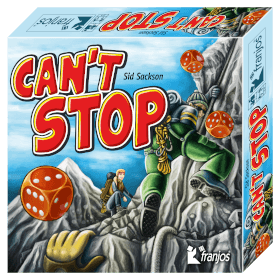Can't Stop
 A fast, simple game of pressing your luck until it breaks! This classic game has stood the test of the decades.
A fast, simple game of pressing your luck until it breaks! This classic game has stood the test of the decades.
Can't Stop is about riding the odds as far as they will take you.
Can't Stop is a pure push your luck game where you roll dice to try and make combinations of numbers, then push those numbers as far as they will go by attempting to roll them over and over again.
The first player two complete three full 'sets' of numbers wins; 7s of easy to get but difficult to complete, whereas rare sets like 2 and 12 are easy to complete, but difficult to roll.
Niver a c'hoarierien: 2 - 4
Padelezh ar bartienn: 6 mn
Kemplezhded : 0 / 5
C'hoari da Can't Stop pe da 1184 c'hoari all enlinenn.
Pellgargañ ret ebet - c'hoariit war-eeun adalek ho merdeer.
Gant ho mignoned ha miliadoù c'hoarierien/ezed en hollved.
Evit netra.

C'hoari da Can't Stop pe da 1184 c'hoari all enlinenn.
Pellgargañ ret ebet - c'hoariit war-eeun adalek ho merdeer.
Gant ho mignoned ha miliadoù c'hoarierien/ezed en hollved.
Evit netra.

Diverradenn ar reolennoù
Can't Stop is a game involving rolling dice and knowing when to stop pushing one's luck.
Rules
Can't Stop is played with a board consisting of 11 columns, numbered from 2 to 12, four dice, and three temporary pieces.
Splitting dice
On a player's turn, they roll the four dice, split the four dice to two groups of two dice however they like, then advance a step on each column whose sum is equal to some group of the dice.
Examples:
- Roll: 3,3,4,4. One can split it to 3,3 and 4,4, advancing a step on each of columns 6 and 8, or 3,4 and 3,4, advancing two steps on column 7.
- Roll: 2,3,4,5. One can split it in three ways: 2,3 and 4,5 (columns 5 and 9), 2,4 and 3,5 (columns 6 and 8), or 2,5 and 3,4 (columns 7 and 7).
- Roll: 4,4,4,6. There is only one way to split it, 4,4 and 4,6, which means columns 8 and 10.
- Roll: 1,1,1,1. There is only one way to split it, 1,1 and 1,1, which means columns 2 and 2.
Temporary pieces
In a turn, a player may only advance in three columns. The temporary pieces are to help the player in keeping track their progresses. However, one must make as many moves as possible.
Examples:
- One hasn't moved at all and rolled 2,3,4,5. They decide to split as 2,3 and 4,5, advancing on columns 5 and 9. This is allowed; they advanced on columns 5,9. They may not choose to advance only on column 5 or only on column 9 because they must perform all moves possible.
- One has moved on columns 4 and 5 and rolled 2,3,4,5. They decide to split as 2,3 and 4,5, advancing on columns 5 and 9. This is allowed; they advanced on columns 4,5,9.
- One has moved on columns 2 and 3 and rolled 2,3,4,5. They decide to split as 2,3 and 4,5, and so should have advanced on columns 5 and 9. But this is not allowed; it makes them advance on four columns. They must pick either 5 or 9 to advance from.
- One has moved on columns 2, 3, and 12 and rolled 2,3,4,5. No matter how they split the dice, they cannot advance.
Stopping one's turn
A player keeps their turn until they state to stop or they cannot advance (like the last of the examples above). In the former case, the temporary pieces are made permanent; they will continue from the positions they have now. In the latter case, the temporary pieces are removed; their position is rolled back to before they have started their turn.
Examples:
- One decides to stop after advancing 3 steps on column 7, 2 steps on column 8, and 1 step on column 9, after previously have advanced 4 steps on column 6 and 3 steps on column 9. Now their position is 4 steps on column 6, 3 steps on column 7, 2 steps on column 8, and 4 steps on column 9.
- One advanced 3 steps on column 7, 2 steps on column 8, and 1 step on column 9, after previously have advanced 4 steps on column 6 and 3 steps on column 9, but then cannot advance. Their position is rolled back to only 4 steps on column 6 and 3 steps on column 9.
Completing a column
When one decides to stop and they have reached the end of some column, that column is scored for that player and no other player may advance in that column. For example, if column 5 has been scored and one splits a 2,3,4,5 to 2,3 and 4,5, they cannot advance on column 5 because it has been scored.
Winning condition
When one scores three columns, they win.
Strategy
The strategy of the game revolves on knowing when to stop. As one keeps playing, they still have the risk of losing all progress on the turn; stopping will save the progress but gives the other players a turn each. Knowing which is more beneficial helps.
Columns with more extreme numbers are less probable (a 2 is only scored by a 1,1 and a 12 is only scored by a 6,6, while a 7 is scored by six pairs of dice), so they have less steps to work on. One's strategy can also revolve on choosing whether to aim for middle columns or extreme columns.

